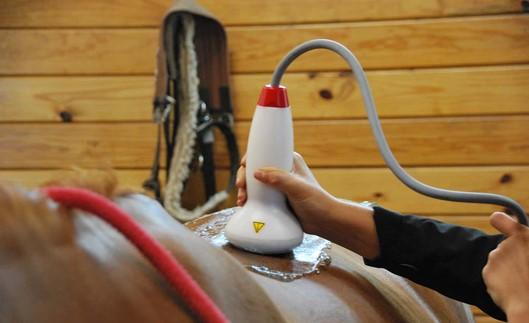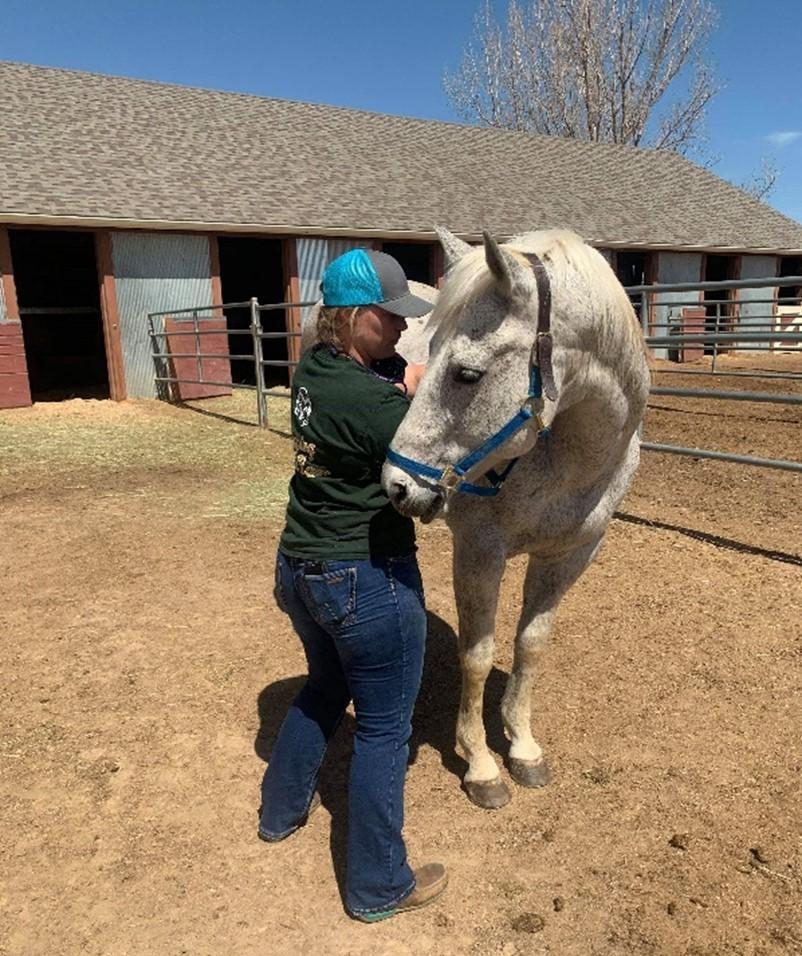Equine Rehabilitation Part II: All the Therapies
Dr. Meg Bacon September 2020
How do you decide which extra therapies are valuable in a rehabilitation program? This completely depends on the timeline and severity of the injury that is being treated. Working with a professional versed in the therapy you choose is important, as they will know how to monitor your horse’s response and progress to therapy. Below are a handful of common modalities and their descriptions that are used as additional therapies to a controlled rehabilitation program.
More Than a Pretty Decoration
Kinesiology tape has been found to have huge potential in the equine patient via several mechanisms. This very elastic sports tape is applied to the equine skin but has effects that penetrate to different layers of the skin and deeper tissue types. The tape has a decompressive effect as it lifts the skin to create space in superficial layers, which then also loosens fascia to allow redirection of the fibers. This translates to reducing and correcting trigger points. Kinesiology tape application can support muscle to aid in the optimization in function, which also helps with joint alignment. Improved joint alignment via improved proprioceptive input can assist horses with soft tissue injuries around joints. The stimulation of sensory receptors can affect the motor control of areas where tape is applied, allowing a horse to better “feel” where his or her limbs are in space. Finally, all this lifting and realignment can greatly enhance lymphatic drainage, which means that congested fluids can become uncongested. This is extremely valuable in reducing inflammation and areas of swelling, which can have a subsequent pain-controlling effect. Different taping techniques are used depending on the reason for its application. The only downside to tape is that the stickiness only lasts a few days before the tape will begin to pull-up and need re-application. Animals can be ridden with tape, and the tape can often provide more continuous support compared to other therapies.

Beam Me Up
Laser therapy, commonly performed with a class IV laser, is an excellent therapy for reducing pain and inflammation by allowing an increased release of pain-relieving endorphins, as well as enhancing the activity of ATP. ATP is a form of cell energy that is needed for many cell functions, including healing. This beneficial energy is like giving your cells a caffeinated beverage. These facets of healing that require energy include cellular proliferation, collagen synthesis, and cytokine production; these are all things essential to healing in soft tissue injuries like tendons and ligaments where blood flow is often limited. Laser therapy is often compared to acupuncture in that it can be used to target specific spots on the body without the invasiveness of needles. Since laser therapy increases cellular activity, it is usually not recommended for young and growing animals, animals with fever, conditions involving cancer, or in animals with blood cell disorders.
Shocking
Extracorporeal Shock Wave Therapy (ESWT), also known as shockwave, is an effective treatment for soft tissue and bone injuries including tendinitis, desmitis, osteoarthritis, and deep muscle pain. It does this by reducing levels of inflammatory mediators, increasing growth factors essential for tissue healing, and increasing stem cell recruitment. Some animals also appreciate pain relief after treatment. Shock wave therapy has become a cornerstone treatment for proximal suspensory ligament injuries in terms of pain relief and speeding up ligament healing. It is often recommended to have three sessions about two weeks apart with a re-evaluation two weeks after the final treatment. Typically, a very small amount of sedation will often be used for this therapy. It is not usually the feeling of the therapy that throws our horses in a tizzy, but the cracking sound that is made when the pulses are emitted from the probe.

Alignment Check
Chiropractors and massage therapists are not just for humans anymore. Sure, some people see a massage therapist to relax, but others really need to see these professionals for misalignments and the muscle fatigue that accompanies them. An animal chiropractor is someone that has gone to veterinary school (Doctor of Veterinary Medicine) or chiropractic school (Doctor of Chiropractic), and then has taken additional intensive coursework and testing in animal chiropractic therapy to become certified. The practitioner should also hold a valid state license. This therapy identifies trigger points in the surrounding tissues secondary to misalignment of the skeletal structure, and then uses specific techniques to put the structure back into appropriate alignment. In Colorado, only a basic massage certification through an occupational therapy school is required. However, you can find a board-certified animal massage/acupressure specialist that has completed additional schooling and testing. This person cannot perform chiropractic adjustments to your animal but can work within the soft tissue structures to relief soft tissue tension and pain.

And the List Goes On
TENS unit, therapeutic ultrasound, and electromagnetic therapy-- the list of adjunctive therapies in rehabilitation truly does go on-and-on. The options for you and your horse will depend on the professionals near you, the equipment available, time available, and budget. Your veterinarian can help discuss available options to you and can usually assist you in seeking out additional professional help when warranted. It is easy to get overwhelmed in a sea of options, but Alpine Equine Hospital is happy to guide you in the decision process for the best program for your horse.
Boldt, Jr E. Veterinary Acupuncture and Chiropracatic: What, When, Who? American Association of Equine Practitioners. 2016. Date accessed 8/27/2020. https://aaep.org/horsehealth/veterinary-acupuncture-and-chiropractic-what-when-who#:~:text=Studies%20have%20shown%20that%20acupuncture,and%20shoeing%20are%20extremely%20important.
Clayton, H. Core Training and Rehabilitation in Horses. Vet Clin Equine 32 (2016) 49-71
McGowan, C., Goff, L. Assessment and treatment of the equine thoracolumbar spine, pelvis and pelvic limb. Animal Physiotherapy: Assessment, Treatment and Rehabilitation of Animals, Second Edition (2016) 317-326.
Molle, S. Kinesio Taping Fundamentals for the Equine Athlete. Vet Clin Equine 32 (2016) 103-113
Schlachter, C. Electrophysical Therapies for the Equine Athlete. Vet Clin Equine 32 (2016) 127-147.
Image 1. Cercier, Danielle. “Equine Back Pain”. Equine Medical Services: Medicine and Reproduction. August 11, 2018.
https://www.equinemedicine.org/equine-back-pain/
Image 2. McClure, Scott. Picture from “ShockWave Therapy” TheHorse.com. February 27, 2017. The Horse Media Group, LLC.
https://thehorse.com/156233/shock-wave-therapy/
